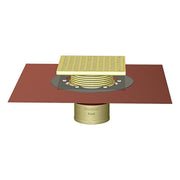Drains
Different Types of Drains
Our versatile drain solutions are crafted for reliable water management in various spaces, combining durability with sleek design.
Effective home drainage systems incorporate various specialized components designed to address specific water management challenges across different areas of a property:
- Roof drains serve as primary collection points for precipitation, typically featuring wide basins and domed strainers that prevent debris infiltration while maintaining optimal flow capacity during heavy rainfall events.
- Deck and balcony drains address the unique requirements of outdoor living spaces, incorporating design features that maintain structural integrity while preventing water infiltration to underlying surfaces. These units often include special flanges for integration with waterproofing membranes and low-profile configurations that minimize trip hazards.
- Parapet and scupper drains provide crucial drainage pathways along roof edges and through vertical walls, respectively, offering essential overflow protection during high-volume precipitation events.
- Shower drains combine functional water removal with aesthetic considerations, available in both traditional center point configurations and contemporary linear designs that complement modern bathroom installations.
Each drain type incorporates specific features optimized for its intended application, ensuring reliable performance in managing water flow across diverse property environments.
Applications
Comprehensive drainage solutions address water management needs across residential, commercial, and institutional properties.
In residential settings, properly designed drainage systems protect structural elements from water damage while enhancing livability and property value.
Commercial applications require robust drains capable of handling higher water volumes and more frequent usage patterns, particularly in high-traffic areas such as commercial bathrooms, kitchen facilities, and expansive roof surfaces.
Institutional settings like educational facilities and healthcare environments benefit from drainage systems that combine maximum reliability with ease of maintenance.
Coastal properties face unique challenges requiring drainage components with enhanced corrosion resistance to withstand salt exposure. Similarly, properties in regions experiencing freeze-thaw cycles benefit from drainage designs incorporating expansion accommodation and freeze protection features.
Understanding these diverse application requirements enables property owners to select appropriate drainage components that provide optimal performance within their specific environmental context and usage patterns.
Benefits of Stainless Steel and Copper
The material composition of drainage components significantly impacts both performance longevity and aesthetic integration.
Stainless steel drains offer exceptional durability with minimal maintenance requirements, resisting corrosion even in challenging environments with high moisture levels or chemical exposure. Their structural integrity remains consistent through temperature extremes, preventing the expansion and contraction issues common with alternative materials.
Copper alternatives provide similar performance benefits while offering a distinctive visual appeal that enhances architectural character. Copper's natural antimicrobial properties provide additional hygienic advantages in applications like shower drains. Both materials maintain their functional capabilities throughout decades of service, with copper developing a distinguished patina that many find aesthetically desirable. This exceptional longevity translates to reduced replacement frequency and lower lifecycle costs despite higher initial investment compared to plastic alternatives.
The sustainability aspects of these materials further enhance their value proposition, as both stainless steel and copper are fully recyclable at the end of their service life.
Drain Price Range
Investment in quality drainage components varies considerably based on application requirements, material selection, and design complexity.
Current pricing for premium drainage solutions ranges from $8 for basic components to $751 for specialized commercial-grade systems with enhanced features.
Entry-level options typically include simple shower drain covers and basic roof drain strainers, while mid-range products encompass complete residential drainage assemblies with improved material quality and performance characteristics.
The upper tier represents comprehensive commercial drainage systems engineered for maximum flow capacity and durability in demanding environments. Copper components generally command higher price points due to material costs and craftsmanship requirements, with custom patination or finishing options further influencing final pricing. When evaluating drainage investments, property owners should consider not only initial purchase cost but also installation requirements, anticipated service life, and potential impact on property protection.
Quality drainage represents a fundamental infrastructure investment that safeguards more costly building components from water damage, ultimately providing substantial return through reduced maintenance and repair expenses throughout the property lifecycle.






























